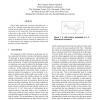Free Online Productivity Tools
i2Speak
i2Symbol
i2OCR
iTex2Img
iWeb2Print
iWeb2Shot
i2Type
iPdf2Split
iPdf2Merge
i2Bopomofo
i2Arabic
i2Style
i2Image
i2PDF
iLatex2Rtf
Sci2ools
ICPR
2006
IEEE
2006
IEEE
Exploiting the Geometry of Gene Expression Patterns for Unsupervised Learning
Typical gene expression clustering algorithms are restricted to a specific underlying pattern model while overlooking the possibility that other information carrying patterns may co-exist in the data. This may potentially lead to a large bias in the results. In this paper we discuss a new method that is able to cluster simultaneously various types of patterns. Our method is based on the observation that many of the patterns that are considered significant to infer gene function and regulatory mechanisms all share the geometry of linear manifolds.
Computer Vision | ICPR 2006 | Information Carrying Patterns | Specific Underlying Pattern | Typical Gene Expression |
Related Content
| Added | 09 Nov 2009 |
| Updated | 09 Nov 2009 |
| Type | Conference |
| Year | 2006 |
| Where | ICPR |
| Authors | Rave Harpaz, Robert M. Haralick |
Comments (0)

